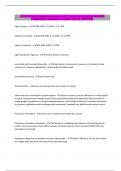ACSM EP Exam | Questions & Answers (100 %Score) Latest Updated 2024/2025
Comprehensive Questions A+ Graded Answers | 100% Pass
Light Intensity - ✔✔30-39% HRR, 2-2.9 METs, 9-11 RPE
Moderate Intensity - ✔✔40-59% HHR, 3-3.5 METs, 12-13 RPE
Vigorous Intensity - ✔✔60% HHR, 6 METs, 14 RPE
Light, Moderate, Vigorous - ✔✔The three levels of intensity
associated with causing tachycardia - ✔✔Ectopic beats, Compensatory pauses, accentuated stroke
volume from valvular regurgitation, bradycardia of sudden onset
beta blockers tend to - ✔✔lower heart rate
proprioception - ✔✔sense of knowing where one's body is in space
Salient features involved with proprioception - ✔✔postural control, precise calibration of limb position
in space, maintenance of steady muscle force production/movement amplitudes, discrimination of
object weight, production of coordinated gait patterns, controlling the timing of muscular contraction
for dynamic stabilization and multisegmental movement, feedback and feed-forward motor control
Pulmonary Ventilation - ✔✔Volume of air inhaled and exhaled per minute
Pulmonary Ventilation calculation - ✔✔Calculated by multiplying the frequency of breathing by the
volume of air moved per breath (tidal volume). Increases linearly until it reached 50-80% VO2 max
(ventilatory threshold)
Repetition range best to promote muscular hypertrophy - ✔✔60-80% 1-RM for 6-20 reps (the heavier
the weight load, the fewer the reps should be performed)
,Social Cognitive Theory 3 primary factors that influence behavior - ✔✔Environment, individual
personality characteristics and experience, behavioral factors.
Environment influence on behavior example (SCT) - ✔✔client's neighborhood and proximity to the gym
Individual personality characteristics and experience influence on behavior example (SCT) - ✔✔how long
the client has been exercising
Behavioral factors influence on behavior example (SCT) - ✔✔how the client behaves in relation to
rewards and punishments
Hedonic Theory - ✔✔the idea that individuals will become accustomed to a positive or negative
stimulus. Feeling good in response to physical activity, and that feeling increases the likelihood of
adherence.
IDEA method - ✔✔A framework to facilitate an action plan for problem solving barriers to physical
exercise. Identify, Develop, Evaluate, Act
Identify (IDEA method) - ✔✔Identify the barrier-be specific and thorough when describing the challenge
and the effect that it has on physical activity
Develop (IDEA method) - ✔✔develop a list of potential solutions-brainstorm in a creative way
Evaluate (IDEA method) - ✔✔evaluate the solution- select one that seems to be appropriate and works
the best
Act (IDEA method) - ✔✔act on the solution- assess how well the plan works and decide what can be
done differently or if another potential solution should be tried
Three stages of general adaptation syndrome - ✔✔Alarm, Resistance, Exhaustion.
,Alarm (general adaptation syndrome) - ✔✔this is when the stressor is first recognized by the system and
a fight or flight response is initiated
Resistance (general adaptation syndrome) - ✔✔this is when a cascade of cardiovascular, metabolic,
hormonal and immune changes is generated as a compensatory stress reaction.
Exhaustion (general adaptation syndrome) - ✔✔this is when the organism has depleted all biochemical
substrates and additional resources and is no longer able to mount a defense against the stressor
General Liability Insurance - ✔✔protects from "ordinary" negligence, and it can be purchased from a
commercial general liability firm
Professional Liability Insurance - ✔✔Protects those who provide professional advice and service as part
of their job responsibility
step tests - ✔✔Queens College, Havard, Astrand-Rhyming
Two major components that largely account for the impacts of a stressor (transactional model of stress
and coping) - ✔✔Event Threat (primary appraisal), Availability of Resources (secondary appraisal).
Event Threat (primary appraisal) - ✔✔Individuals gauge both their susceptibly and severity of the threat
(will I be in trouble if I don't do this workout)
Availability of Resources (secondary appraisal). - ✔✔Individuals evaluate the available resources to
control and cope with the stressor (is there water near by)
The recommended amount of time for physical activity for adults of all ages and life stages is between -
✔✔150-300 minutes each week (30-60 mins/day)
For older adults who are in good physical shape, what is the recommended amount of time to hold a
stretch? - ✔✔30-60 seconds
, General amount of time to hold a stretch - ✔✔10-30 seconds
Ebbeling Single-Stage Submaximal Treadmill Walking Test protocol - ✔✔1. Warm up for 4 mins at 0%
grade and a walking speed between 2.0 and 4.5mph that elicits 50-70% of age predicted HRmax
2. Following warmup, elevate the treadmill to a 5% grade and continue for an additional 4 mins at a
speed of 2.0, 3.0, 4.0, or 4.5mph. Record the steady-state HR from the average of the final 30 seconds of
the last 2 minutes at the 5% grade. if HR differs for more than 5 bpm, extend the test by an additional
minute and record that SSHR from the new final 2 minutes.
3. Enter the SS HR into the equation: VO2max=15.1 + (21.8 x speed mph)-0.327 x SS HR) - (0.263 x speed
mph x age years) + 0.00504 x SS HR x age) + (5.98 x gender: female 0, male 1)
3 days per week, moderate, 5-10 exercises. 1-3 sets or 10-15 reps, compound movements - ✔✔FITT for
pregnant people with Gestational Diabetes Melitus
Passive (traditional flexibility training) - ✔✔Slow and constant stretch with a partner
Self (traditional flexibility training) - ✔✔Slow and constant stretch with no assistance
Isometric (traditional flexibility training) - ✔✔Slow and constant stretch against a stationary object
Ballistic Stretching - ✔✔focuses on rapid and bounce-like movements. the momentum from bouncing
helps to push the joint through the full ROM
Proprioceptive Neuromuscular Facilitation (PNF) - ✔✔involves contraction and release techniques.
Static Flexibilty - ✔✔focuses on slow and constant motion that is held at the point of mild discomfort for
about 10 to 30 seconds.
FITT that are recommended for aerobic exercise for clients who are overweight or obese and just
beginning a fitness program - ✔✔5 days per week, 40-59% HRR, 150 mins per week, focus on large
muscle groups (swimming)




